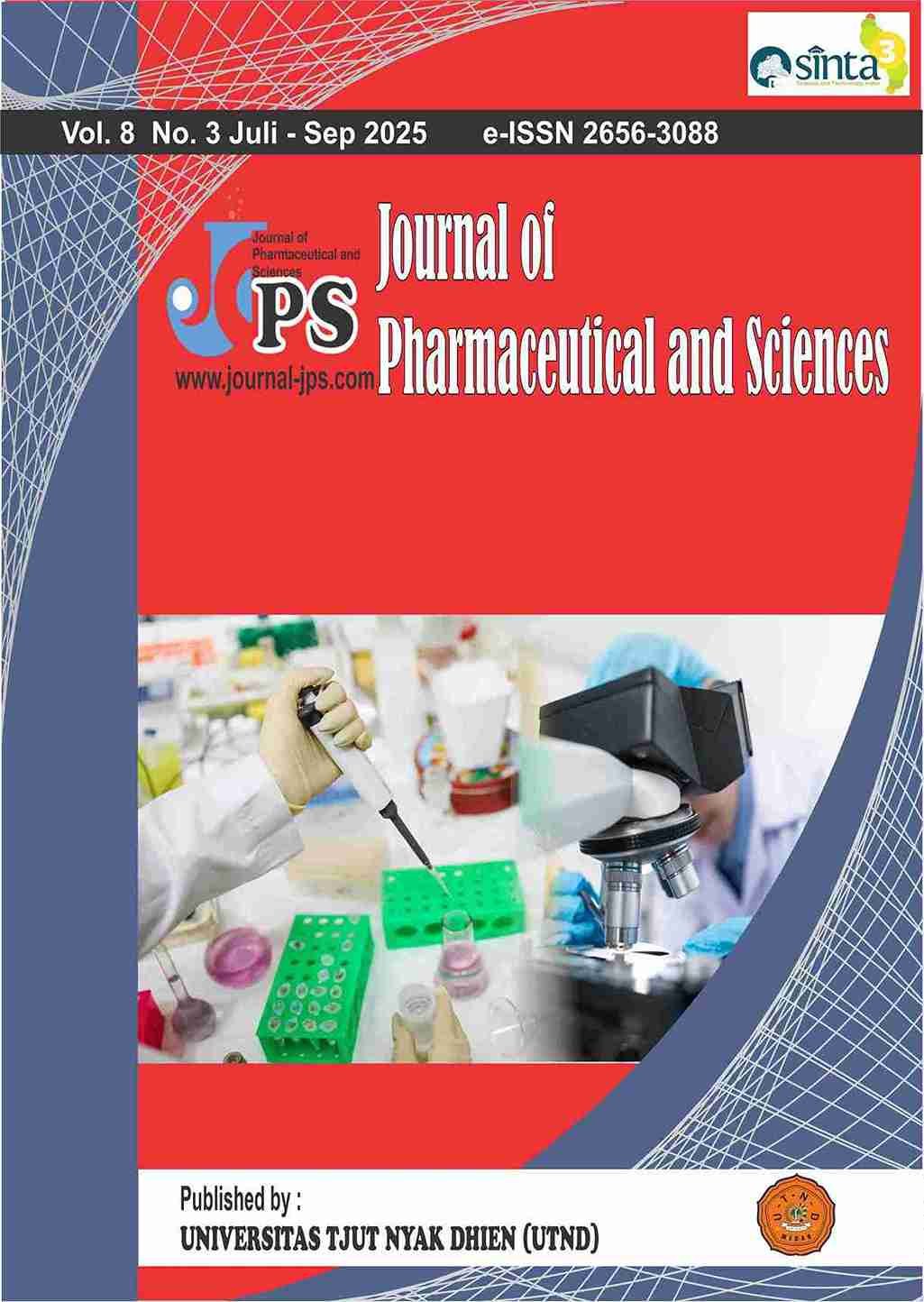Potential Drug Interactions in Liver Cirrhosis: Patterns and Sociodemographic Factors
Main Article Content
Page: 2118-2126
Abstract
Liver cirrhosis is a chronic condition characterised by the formation of regenerative nodules and fibrotic tissue resulting from prolonged liver damage. This condition is frequently accompanied by comorbidities and complications, often leading to the use of multiple medications (polypharmacy). Polypharmacy increases the risk of potential drug interactions, which may worsen clinical outcomes. This study aimed to describe the patterns of possible drug interactions and the sociodemographic characteristics of hospitalised patients with cirrhosis at Dr M. Djamil Central General Hospital in Padang. A cross-sectional study was conducted using prospectively collected data from patient medical records. A total of 579 medications used by 50 patients were classified into three categories: cirrhosis-specific drugs (48.9%), symptomatic treatments (43.2%), and medications for comorbid conditions (7.95%). Analysis with drugs.com showed potential drug interactions in 96% of patients, most commonly moderate–to–minor combinations (48%), followed by major, moderate, and minor interactions (22%). In comparison, moderate interactions only and major moderate combinations occurred in 18% and 9% of patients, respectively. In terms of sociodemographic characteristics, most patients were male (58%), under 65 years old (64%), had more than one comorbidity (52%), had a basic education level (32%), were still employed (56%), and did not engage in high-risk social behaviors such as smoking or alcohol consumption (48%).
Downloads
Article Details

This work is licensed under a Creative Commons Attribution-NonCommercial-ShareAlike 4.0 International License.
References
DiPiro JT, Yee GC, Haines ST, Nolin TD, Ellingrod VL, Posey LM. DiPiro’s Pharmacotherapy : A Pathophysiologic Approach, 12th Edition. USA: McGraw-Hill LLC; 2023.
Devarbhavi H, Sumeet K, Asrani, Juan Pablo Arab, Yvonne Ayerki Nartey, Elisa Pose PSK. Global Burden of Liver Disease: 2023 Update. J Hepatol 2023;79:516 37. https://doi.org/10.1016/j.jhep.2023.03.017. DOI: https://doi.org/10.1016/j.jhep.2023.03.017
Kemenkes. Survei Kesehatan Indonesia. Jakarta: 2023.
Farooq J, Sana MM, Chetana PM, Almuqbil M, Prabhakar Bhat N, Sultana R, et al. Polypharmacy in chronic liver disease patients: Implications for disease severity, drug-drug interaction, and quality of life. Saudi Pharm J 2023;31:101668. https://doi.org/10.1016/j.jsps.2023.06.001. DOI: https://doi.org/10.1016/j.jsps.2023.06.001
Olkkola KT, Ahonen J. Drug interactions. Vol. 14. 2001. https://doi.org/10.1097/00001503-200108000-00006. DOI: https://doi.org/10.1097/00001503-200108000-00006
Vaja R, Rana M. Drugs and the liver. Anaesth Intensive Care Med 2023;24:536–42. https://doi.org/10.1016/j.mpaic.2023.05.021. DOI: https://doi.org/10.1016/j.mpaic.2023.05.021
Rabba AK, Abu Hussein AM, Abu Sbeih BK, Nasser SI. Assessing Drug-Drug Interaction Potential among Patients Admitted to Surgery Departments in Three Palestinian Hospitals. Biomed Res Int 2020;2020. https://doi.org/10.1155/2020/9634934. DOI: https://doi.org/10.1155/2020/9634934
Muti AF, Anindya C. Analysis of Potential Drug-Drug Interactions in Liver Cirrhosis Patients. J Farm Galen (Galenika J Pharmacy) 2021;7:17–28. https://doi.org/10.22487/j24428744.2021.v7.i1.15148. DOI: https://doi.org/10.22487/j24428744.2021.v7.i1.15148
Usman FH, Birman Y, Wahyuni S. Profil Pasien Sirosis Hepatis di RSUP Dr. M. Djamil Padang Tahun 2021. Heal Med J 2025;7:29–42. DOI: https://doi.org/10.33854/heme.v7i1.1635
Rubin JB, Sundaram V, Lai JC. Gender differences among patients hospitalised with cirrhosis in the United States. J Clin Sleep Med 2020;54. DOI: https://doi.org/10.1097/MCG.0000000000001192
Carrier P, Debette-Gratien M, Jacques J, Loustaud-Ratti V. Cirrhotic patients and older people. World J Hepatol 2019;11:663–77. https://doi.org/10.4254/wjh.v11.i9.663. DOI: https://doi.org/10.4254/wjh.v11.i9.678
Ames JB, Djerboua M, Terrault NA, Booth CM, Flemming JA. Rising Healthcare Costs and Utilisation among Young Adults with Cirrhosis in Ontario: A Population-Based Study. Can J Gastroenterol Hepatol 2022;2022. https://doi.org/10.1155/2022/6175913. DOI: https://doi.org/10.1155/2022/6175913
Coppel S, Mathur K, Ekser B, Patidar KR, Orman E, Desai AP, et al. Extra-hepatic comorbidity burden significantly increases 90-day mortality in patients with cirrhosis and high model for end-stage liver disease. BMC Gastroenterol 2020;20:1–11. https://doi.org/10.1186/s12876-020-01448-z. DOI: https://doi.org/10.1186/s12876-020-01448-z
Jepsen P. Comorbidity in cirrhosis. World J Gastroenterol 2014;20:7223–30. https://doi.org/10.3748/wjg.v20.i23.7223. DOI: https://doi.org/10.3748/wjg.v20.i23.7223
Koutny F, Aigner E, Datz C, Gensluckner S, Maieron A, Mega A, et al. Relationships between education and non-alcoholic fatty liver disease. Eur J Intern Med 2023;118:98–107. https://doi.org/10.1016/j.ejim.2023.07.039. DOI: https://doi.org/10.1016/j.ejim.2023.07.039
Stroffolini T, Sagnelli E, Sagnelli C, Morisco F, Babudieri S, Furlan C, et al. The association between education level and chronic liver disease of any aetiology. Eur J Intern Med 2020;75:55–9. https://doi.org/10.1016/j.ejim.2020.01.008. DOI: https://doi.org/10.1016/j.ejim.2020.01.008
Vaz J, Strömberg U, Eriksson B, Buchebner D, Midlöv P. Socioeconomic and marital status among liver cirrhosis patients and associations with mortality: a population-based cohort study in Sweden. BMC Public Health 2020;20:1–13. https://doi.org/10.1186/s12889-020-09783-2. DOI: https://doi.org/10.1186/s12889-020-09783-2
Osna NA, Donohue TM, Kharbanda KK. Alcoholic liver disease: Pathogenesis and current management. Alcohol Res Curr Rev 2017;38:7–21. DOI: https://doi.org/10.35946/arcr.v38.2.01
Roerecke M, Vafaei A, Hasan OS, Chrystoja BR, Cruz M, Lee R, et al. Alcohol consumption and risk of liver cirrhosis: a systematic review and meta-analysis. Physiol Behav 2019;114. https://doi.org/10.1177/0022146515594631.Marriage. DOI: https://doi.org/10.14309/ajg.0000000000000340
Rutledge SM, Asgharpour A. Smoking and liver disease. Gastroenterol Hepatol 2020;16:617–25.
MIMS. Drug Information 2025.
Ezeriņa D, Takano Y, Hanaoka K, Urano Y, Dick TP. N-Acetyl Cysteine Functions as a Fast-Acting Antioxidant by Triggering Intracellular H 2 S and Sulfane Sulfur Production. Cell Chem Biol 2018;25:447-459.e4. https://doi.org/10.1016/j.chembiol.2018.01.011. DOI: https://doi.org/10.1016/j.chembiol.2018.01.011
DrugBank. Drugs 2025.
Kalaitzakis E. Gastrointestinal dysfunction in liver cirrhosis. World J Gastroenterol 2014;20:14686–95. https://doi.org/10.3748/wjg.v20.i40.14686. DOI: https://doi.org/10.3748/wjg.v20.i40.14686
Liu, Qiang, Wang H, Lv, Shengyin Zhao, Yanyan Zheng, Yabin Li, Guanyu Wang W. The Combined Use of Levodopa/Benserazide and Pramipexole Proves Beneficial for Managing Parkinson’s Disease. Actas Esp Psiquiatr 2024;52:769–76. https://doi.org/10.62641/aep.v52i6.1711. DOI: https://doi.org/10.62641/aep.v52i6.1711
Stalevo JP. A pioneering treatment for OFF periods in Parkinson's disease. Eur J Neurol 2023;2:3–8. DOI: https://doi.org/10.1111/ene.15994
Hansel TT, Tan AJ, Barnes PJ, Min Kon O. Anticholinergic bronchodilators. Asthma and COPD: Basic Mechanisms and Clinical Management. 2008; 615–26. https://doi.org/10.1016/B978-0-12-374001-4.00049-3. DOI: https://doi.org/10.1016/B978-0-12-374001-4.00049-3
Patel RI, Breckett RD. Evaluation of resources for analysing drug interactions. J Med Libr Assoc 2016;10:290–5. https://doi.org/10.3163/1536-5050.104.4.008. DOI: https://doi.org/10.3163/1536-5050.104.4.007
Sancar M, Okuyan B, Apikoglu-Rabus S, Izzetin FV. Determination of potential drug–drug interactions using various software programs in a community pharmacy setting. Turk J Pharm Sci 2018;15:163–7. https://doi.org/10.4274/tjps.30932. DOI: https://doi.org/10.4274/tjps.30932
Castro-Pastrana LI, Fernández-Llamazares CM, Pérez-Moreno MA et al. Qualitative evaluation of the structure, content, and consistency of ten mobile applications providing drug–drug interaction information. Int J Med Inf 2021;152. https://doi.org/10.1016/j.ijmedinf.2021.104478.





